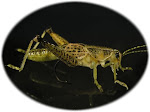I get lots of questions about legs. I use mono for most of my legs. It works great in production and has the durability Realistic fishing flies need. Still we worked with varieties of materials in the beginning. Almost all of them natural. The techniques discribed below are for those who wish to truely tye their Realistic flies and prefer natural materials.
The Feather is from a Ringneck Pheasant cape. It's the perfect size for a medium to large Orb Weaver or Black Widow.
You can leave a tiny amount of barb material at the tips to replicate toe hooks. Bends shown below are from using my thumb nail and first finger. Make sure you know the distance between the bends and the direction of all the bends before you start. This includes the small section at the butt end of the quill. In other words use adequate reference.
No glue, no thread, nothing artificial just the perfect material. Not good for production runs but small groups are easy.

For color I used a marker. If necessary coat the leg with Flexament or Hard as Nails polish and re-color. I coat them anyway with Flexament for durability. Coloring is easier off of the fly rather than on.
Four Porcupine quill sections are then tyed together like a raft. Then they are tyed to the underside of the hook. At this point you can finish tying your Spider without the legs being in the way.
Next with a Beading needle and thread run the thread through the end of the Feather quill and out the first joint. Tye it off at the joint. Now run your thread through the first section of Porcupine quill. Do the same with the second leg.

Pull both legs in to the open sockets and tye them off on opposite legs. Of course this will be done on the hook with the finished Spider.





